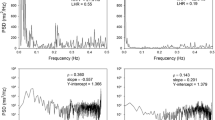Abstract
Attenuated cardiac parasympathetic activity appear to be an important risk factor contributing to sudden cardiac death in subjects with overt coronary disease but its predictive value in otherwise healthy normal subjects is not known. We have for 8 years followed 260 apparently healthy adult subjects who underwent Hotler monitoring. Twelve died, 14 developed ischaemic heart disease and four suffered sudden cardiac death. A healthy control subject was matched, along with other risk factors, for each case. In each subject 24-h heart rate variability was calculated as the deviation of all normal R—R intervals from mean R—R (SD) and the percentage of successive R—R interval differences exceeding 6% (%DIF6%)—this was used as an index of cardiac parasympathetic activity. There were no significant differences in heart rate variability between the cases developing problems and controls. In the sudden cardiac death victims, however, there was a clear trend towards lower heart rate variability. In them waketime mean SD was 73 ms versus 85 ms for cases and controls respectively (p = 0.08), and for sleeptime 61 ms versus 76 ms (p = 0.07). Compared to normal limits for heart rate variability obtained in 140 subjects that remained healthy for 8 years, figures for both SD and %DIF6% in sudden cardiac death subjects were at or below 95% confidence limits. The results indicate that altered autonomic balance may contribute to sudden cardiac death even in apparently healthy subjects. Subjects with a low 24-h heart rate variability on Holter monitoring may be predicted at an early stage of being at greater risk. This has considerable implications not only for predicting subjects at risk but for assessing physiological (such as exercise) and pharmacological interventions which may reduce such risk.
Similar content being viewed by others
References
Bayés de Luna A, Coumel P, Leclercq JF. Ambulatory sudden cardiac death: mechanisms of production of fatal arrhythmia on the basis of data from 157 cases.Am Heart J 1989;117: 151–159.
Friedman GD, Klatsky AL, Sieglaub AB. Predictors of sudden cardiac death.Circulation 1975;51 (suppl III): 164–169.
Kannel WB, Kannel C, Paffenbarger RS, Adrienne Cupples PH, Adrienne Cupples L. Heart rate and cardiovascular mortality: the Framingham study.Am Heart J 1987;113: 1489–1494.
Tibblin G, Eriksson CG, Bjuro T, Georgescu D, Svardsudd C. Heart rate and heart rate variability as a risk factor for the development of ischemic heart disease (IHD) in the ‘men born in 1913 study’—a ten years follow-up.IRCS medical science: cardiovascular system 1975;3: 95.
Billman G, Schwartz PJ, Stone HL. Baroreceptor control of heart rate: a predictor of sudden cardiac death.Circulation 1982;66: 874–880.
Kleiger RE, Miller JP, Bigger JT, Moss AJ, and The Multicenter Post-Infarction Research Group. Decreased heart rate variability and its association with increased mortality after myocardial infarction.Am J Cardiol 1987;59: 256–262.
Cripps TR, Malik M, Farrell TG, Camm AJ. Prognostic value of reduced heart rate variability after myocardial infarction: clinical evaluation of a new analysis method.Br Heart J 1991;65: 14–19.
Martin GJ, Magid NM, Myers G, Barnett PS, Schaad JW, Weiss JS, Lesch M, Singer DH. Heart rate variability and sudden death secondary to coronary artery disease during ambulatory electrocardiographic monitoring.Am J Cardiol 1987;60: 86–89.
Ewing DJ, Neilson JMM, Travis P. New method for assessing cardiac parasympathetic activity using 24 hour electrocardiograms.Br Heart J 1984;52: 396–402.
Fulan R, Guzzetti S, Crivellaro W, Dassi S, Tinelli M, Baselli G, Cerutti S, Lombardi F, Pagani M, Malliani A. Continuous 24-hour assessment of the neural regulation of systemic arterial pressure and RR variabilities in ambulant subjects.Circulation 1990;81: 537–547.
Bjerregaard P. Mean 24-hour heart rate, minimal heart rate and pauses in healthy subjects 40–79 years of age.Eur Heart J 1983;4: 44–51.
Mølgaard H, Sørensen KE, Bjerregaard P. Minimal heart rates and longest pauses in healthy adult subjects on two occasions eight years apart.Eur Heart J 1989;10: 758–764.
Mølgaard H, Sørensen KE, Bjerregaard P. Circadian variation and influence of risk factors on heart rate variability in healthy subjects.Am J Cardiol 1991 (in press).
Mølgaard H. Evaluation of the Reynolds Pathfinder II system for 24 hour heart rate variability analysis.Eur Heart J 1991;12: (in press).
Bigger JT, Kleiger RE, Fleiss JL, Rolnitzky LM, Steinman RC, Miller JP and the multicenter post-infarction research group. Components of heart rate variability measured during healing of acute myocardial infarction.Am J Cardiol 1988;61: 208–215.
Huikuri HV, Kessler KM, Terracall E, Castellanos A, Linnaluoto MK, Myerburg RJ. Reproducibility and circadian rhythm of heart rate variability in healthy subjects.Am J Cardiol 1990;65: 391–393.
Bjerregaard P, Sørensen KE, Mølgaard H. Predictive value of ventricular premature beats for subsequent ischaemic heart disease in apparently healthy subjects.Eur Heart J 1991;12: 597–601.
Billman GE, Schwartz PJ, Stone HL. The effects of daily exercise on susceptibility to sudden cardiac death.Circulation 1984;69: 1182–1189.
Åblad B, Bjurö T, Björkman JA, Edström T, Olsson G. Role of central nervous beta-adrenoreceptors in the prevention of ventricular fibrillation through augmentation of cardiac vagal tone.JACC 1991;17: 165A (abstract).
Author information
Authors and Affiliations
Rights and permissions
About this article
Cite this article
Mølgaard, H., Sørensen, K.E. & Bjerregaard, P. Attenuated 24-h heart rate variability in apparently healthy subjects, subsequently suffering sudden cardiac death. Clinical Autonomic Research 1, 233–237 (1991). https://doi.org/10.1007/BF01824992
Received:
Accepted:
Issue Date:
DOI: https://doi.org/10.1007/BF01824992




